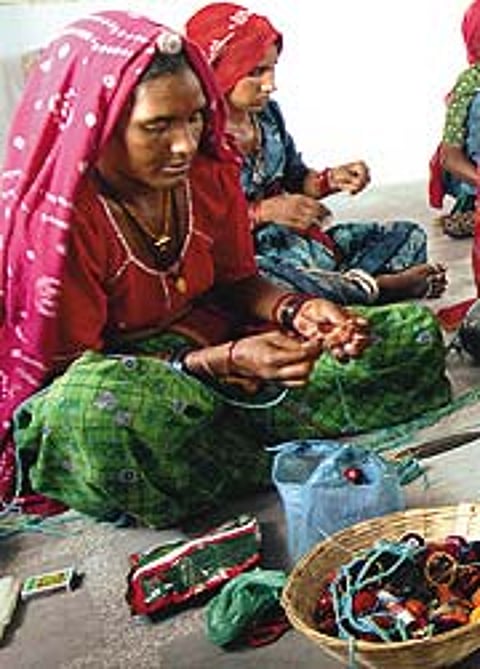A Thar Spring
A woman sarpanch rewrites the script in an 'inured' Rajasthan village

That was only the beginning of the frenzy of construction the panchayat has overseen. It has built anganwadis, a new secondary school, public toilets and a veterinary clinic.

Some village roads now have streetlights. In Surwas, there is now a community centre where a self-employment project tries to help women earn their living making handicrafts like bags and curtain-tassels out of the local wild grass. The women who work there are spared the hard labour packing salt at the salt-fields—where they couldn't mind the children, and earned just Rs 30 a day.
The panchayat office in Gopalpura has been renovated, adding a computer room and a village assembly hall. Twice a month they hold meetings there, open to the entire village. In the backyard, an orange-and-white telecom antenna rises incongruously out of the scrub. It will enable broadband internet and teleconferencing in the village—allowing the villagers to consult medical specialists in urban hospitals face-to-face. The heart of Gopalpura is a 400-year-old lingam, around which a temple called the Drona Parvat Sankhla has grown. "Gopalpura used to be called Dronapur," Rathi says, "The sage Drona did tapasya on the hills over there." The panchayat collected Rs 20 lakh in private donations to renovate the mandir.
But the most sacred work in this environment will always be bringing water. "Jal nahi toh kal nahi. The trouble is, the groundwater is very salty," says deputy sarpanch Hanuman Naram. "We're trying very hard to conserve our sweet water." At the foot of the mandir is a large tank, built earlier as part of a water-harvesting project. "It was never maintained," Rathi says. "It fills with rainfall from the nearby hills, but illegal mining had drawn away all the run-off. It was so dry, people joked about turning it into a football field."
Shutting down the mining operations was the first hard fight. Then, when the tank filled, they had to stop people from drawing water to sell. That was another battle—against the interests of a local caste group—but today the tank is brimming, a sight to behold and one of the few sources of potable water in the village.
Infrastructure is only half the battle. Who will use the internet if they can't read? The panchayat's major social thrust has been in education, especially for girls—'Anpadh nari nahi rahegi.' The girls' school has been upgraded to take students till Class XII, and the co-ed school till Class X. The panchayat has convinced almost all the families, and with the help of an accelerated learning programme for girls who have never been in school, it estimates that 90 per cent of Gopalpura's children are on their way to literacy.
There is more: family planning programmes. A public hygiene campaign that won Gopalpura the Nirmal Gram Yojna Puraskar last year. And to capitalise on its proximity to the Tal Chhapar Blackbuck sanctuary right next door, the zenana quarters of a village fort has been refitted as five sunny hostel rooms. So much is being done that the panches can barely catalogue their work.
Gram panchayats in Rajasthan are pinched, malnourished institutions. The state, having passed robust legislation for the empowerment of panchayats, refuses to actually hand over any meaningful activities or money to them. Rathi bristles as she talks about it. "The state only provides Rs 8 lakh per year, all in tied funds, which means they come with more guidelines on what we can't do than what we can," she says. In fact, in terms of delivering services, panchayats in states like Kerala commonly outstrip Gopalpura's best efforts. In those states, it is the system that does the heavy lifting. "In Kerala, panchayats can even levy their own taxes," she sighs, "Here, we have guidelines that say we can levy a tax on any vehicle not listed in the Motor Vehicles Act—which leaves us with camel carts! If we were like Kerala, we could fly."
She also has a vision. Before her campaign, she drafted and computerised a 2005-25 masterplan for the development of Gopalpura. It includes phased proposals, census figures, maps and such considerations as the ideal population density for the village centre. It is written with a technical diligence that would be reassuring—and surprising—to find in a planning document about South Delhi. This impressive document is the stick she uses to goad bureaucrats.
The way her stars are aligned, it's clear that if she desires, Rathi can make an MLA, even an MP, out of herself within a decade. A glint in her eye shows she's aware of it. Gopalpura's residents are aware as well.
"She'll move up, and we won't find another sarpanch like her," says Nemi Chand Prajapat, who recently returned from working in Delhi. "But we want our sarpanch to advance—we've dreamed of having a sarpanch like this, and we dream of her advancement as well."
It is, in any case, still only the middle of the panchayat's five-year term. "This is our mid-day hour," she says brightly. And the sun shines on Gopalpura.
Tags